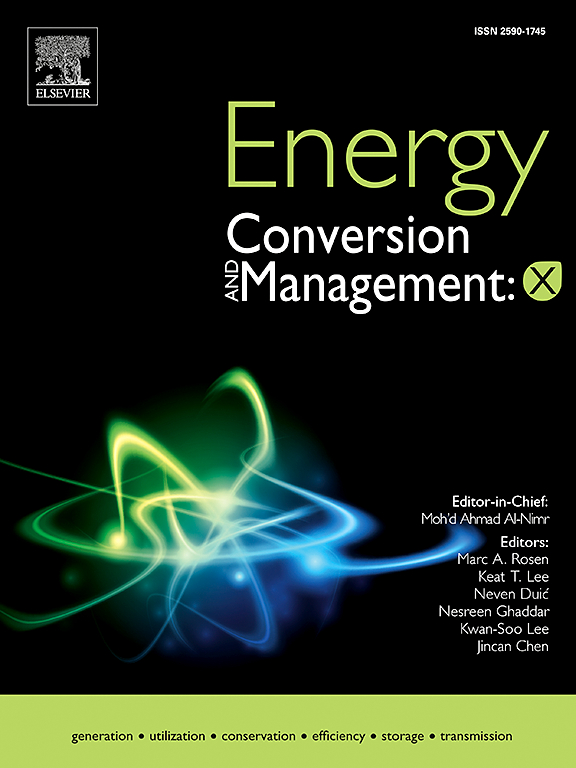Optimization and evaluation of operational and economic performance of grid-connected battery storage at different stages of battery health
IF 7.1
Q1 ENERGY & FUELS
引用次数: 0
Abstract
Battery storage systems play a crucial role in modern energy infrastructure by enhancing grid flexibility. However, their long-term performance is limited by capacity degradation, which impacts operational efficiency and economic viability. This study proposes a degradation-aware optimization framework to evaluate the operational and economic performance of grid-connected battery systems across different stages of battery health, including new, mid-life, and near end-of-life conditions. The framework dynamically optimizes daily operational schedules, including cycle frequency, charge /discharge timing, and durations, in response to evolving degradation. The objective of optimization is to simultaneously maximize revenue and minimize degradation-related cost. The model incorporates both calendric and cyclic aging as functions of real-life operational conditions, ensuring informed and adaptive battery management.
The results demonstrate that, despite a reduction in energy output per cycle from 95% in the first year to 77% near end-of-life, the proposed strategy stabilizes revenue across all stages by adjusting cycle characteristics. In the early stage, cycling is limited to once per day on over 80% of days, with extended charge/discharge durations (4–8 h) to mitigate initial degradation. In later stages, the strategy shifts to shorter charge/discharge durations (1–2 h) and increases the frequency to two cycles per day on up to 60% of days, thereby sustaining profitability. The findings offer valuable insights for grid operators, investors, and energy market participants in developing financially viable battery storage systems.
不同健康状态下并网蓄电池运行经济性优化与评价
电池储能系统通过提高电网的灵活性,在现代能源基础设施中发挥着至关重要的作用。然而,它们的长期性能受到容量退化的限制,这影响了运营效率和经济可行性。本研究提出了一个退化感知优化框架,以评估并网电池系统在电池健康的不同阶段的运行和经济性能,包括新的、中期的和接近寿命结束的条件。该框架动态优化日常运行计划,包括循环频率、充放电时间和持续时间,以响应不断变化的退化。优化的目标是同时最大化收益和最小化与退化相关的成本。该模型将日历和循环老化作为实际操作条件的功能,确保知情和自适应电池管理。结果表明,尽管每个周期的能源输出从第一年的95%减少到接近寿命结束时的77%,但所提出的策略通过调整周期特性来稳定所有阶段的收入。在早期阶段,循环限制为每天一次,超过80%的天,延长充电/放电持续时间(4-8小时),以减轻初始退化。在后期阶段,该策略转向缩短充放电持续时间(1-2小时),并将频率提高到每天两次,最多可达到60%的天数,从而保持盈利能力。研究结果为电网运营商、投资者和能源市场参与者开发经济上可行的电池存储系统提供了有价值的见解。
本文章由计算机程序翻译,如有差异,请以英文原文为准。
求助全文
约1分钟内获得全文
求助全文
来源期刊

Energy Conversion and Management-X
Multiple-
CiteScore
8.80
自引率
3.20%
发文量
180
审稿时长
58 days
期刊介绍:
Energy Conversion and Management: X is the open access extension of the reputable journal Energy Conversion and Management, serving as a platform for interdisciplinary research on a wide array of critical energy subjects. The journal is dedicated to publishing original contributions and in-depth technical review articles that present groundbreaking research on topics spanning energy generation, utilization, conversion, storage, transmission, conservation, management, and sustainability.
The scope of Energy Conversion and Management: X encompasses various forms of energy, including mechanical, thermal, nuclear, chemical, electromagnetic, magnetic, and electric energy. It addresses all known energy resources, highlighting both conventional sources like fossil fuels and nuclear power, as well as renewable resources such as solar, biomass, hydro, wind, geothermal, and ocean energy.
 求助内容:
求助内容: 应助结果提醒方式:
应助结果提醒方式:


